This article is written like a travel guide .(October 2010) |
Ramgarh is a village in Chhattisgarh, India; the nearest large town is Ambikapur. [1] The Ramgarh hills are nearby. Famous Jogimara and Sitabenga Caves are situated in these hills.
This article is written like a travel guide .(October 2010) |
Ramgarh is a village in Chhattisgarh, India; the nearest large town is Ambikapur. [1] The Ramgarh hills are nearby. Famous Jogimara and Sitabenga Caves are situated in these hills.
The Ramgarh hills are a popular tourist destination. [2] There are many caves in Ramgarh. It is believed to be the most ancient theatre in the world.
It is also believed that lord Rama has come here and lived during his exile. This is the theatre of Kalidas (one of the biggest poets in world of Sanskrit). Here, if someone speaks in the theatre his/her sound can be heard far away. In another cave there are some paintings of ancient times. Also there is a long hole, it is believed that when lord Ram lived here, this hole was used to keep a watch on invaders. It is also believed that Ramgarh lay on the way to Lanka.

Chhattisgarh is a landlocked state in Central India. It is the ninth largest state by area, and with a population of roughly 30 million, the seventeenth most populous. It borders seven states – Uttar Pradesh to the north, Madhya Pradesh to the northwest, Maharashtra to the southwest, Jharkhand to the northeast, Odisha to the east, Andhra Pradesh and Telangana to the south. Formerly a part of Madhya Pradesh, it was granted statehood on 1 November 2000 with Raipur as the designated state capital. Chhattisgarh is one of the fastest-developing states in India. Its Gross State Domestic Product (GSDP) is ₹5.09 lakh crore (US$59 billion), with a per capita GSDP of ₹152,348 (US$1,800). A resource-rich state, it has the third largest coal reserves in the country and provides electricity, coal, and steel to the rest of the nation. It also has the third largest forest cover in the country after Madhya Pradesh and Arunachal Pradesh with over 40% of the state covered by forests.
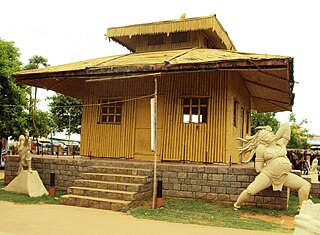
Parnasala is a village in the Dummugudem mandal in the newly formed Bhadradri Kothagudem district of Telangana, India. The village is accessible by road and boats and is situated 32 km from the temple town of Bhadrachalam.
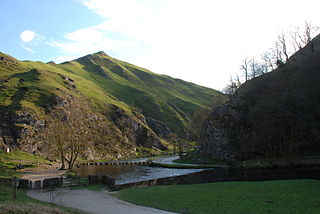
Dovedale is a valley in the Peak District of England. The land is owned by the National Trust and attracts a million visitors annually. The valley was cut by the River Dove and runs for just over 3 miles (5 km) between Milldale in the north and a wooded ravine, near Thorpe Cloud and Bunster Hill, in the south. In the wooded ravine, a set of stepping stones cross the river and there are two caves known as the Dove Holes.

Antalya Province is a province and metropolitan municipality of Turkey. It is located on the Mediterranean coast of south-west Turkey, between the Taurus Mountains and the Mediterranean Sea. Its area is 20,177 km2, and its population is 2,688,004 (2022).

Gupteswar Cave is a cave shrine dedicated to Shiva, one of the key gods in Hinduism. It is a pilgrim site situated about 55 km (34 mi) away Jeypore, Koraput District in the state of Odisha, India. It is a limestone cave, and its main attraction is the gigantic Shiva Linga which is said to be increasing in size. It is believed that the cave was discovered by Rama and re-discovered in the reign of Maharajah Veer Vikram Dev. In the holy month of Shravan, the cave is visited by devotees who walk to the shrine bare-footed with decorated bamboo palanquins called "Kanwadiya" and bathe in the maha kund before worshipping Lord Gupteshwar. There are 200 steps to reach to the Shiva linga temple. Its entrance is about 3 metres (9.8 ft) wide and 2 metres (6.6 ft) high.
Malkangiri, historically known as Malikamardhangiri, is a town and municipality in Malkangiri district in the Indian state of Odisha. It is the headquarter of the Malkangiri district. Malkangiri has been the new home of the East Bengali refugees from erstwhile East Pakistan, who have been rehabilitated since 1965 under the Dandakaranya Project. Some Sri Lankan Tamil refugees were also rehabilitated in the town, following the armed struggle of the Liberation Tigers of Tamil Eelam (LTTE) in the early 1990s, although most of them have now returned to their country. Currently, it is one of the most naxalite-affected areas of the state, and is a part of the Red Corridor.

Dongargarh is a town and municipality in Rajnandgaon District in the state of Chhattisgarh, India and the site of the Bambleshwari Temple and Chandragiri Jain Temple. A prominent pilgrim destination in Rajnandgaon District, the city lies about 35 kilometres (22 mi) west from Rajnandgaon, 67 kilometres (42 mi) west from Durg and 132 kilometres (82 mi) east from Bhandara which are situated on National Highway 6. Featuring majestic mountains and ponds, Dongargarh is derived from the words: Dongarh meaning 'mountains' and garh meaning 'fort'. It is also a best tourism place in Chhattisgarh

Ramgarh Cantonment, usually referred to as Ramgarh Cantt or just Ramgarh is a cantonment town, belonging to the Ramgarh district of the Indian state of Jharkhand. Historically, a subdivision of the larger Hazaribag district, Ramgarh was finally elevated to a district status on 12 September 2007 largely to ease administrative hardships.
Ramgarh may refer to:
Bettadapura is a village located in Mysore district, in the Indian state of Karnataka. The name is derived from two Kannada words, "Betta" and "pura". Betta means "hill" and pura means "town". As per census survey of India 2011, the location code number assigned to Bettadapura is 618171.

Ramgarh district is one of the 24 districts in the Indian state of Jharkhand. It was also a military district during the British Regime, referred to then as Ramgarh district. It is the part of State Capital Region (SCR).
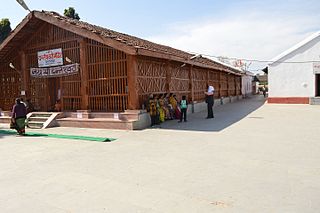
Danteshwari Temple is Hindu temple, dedicated to Goddess Danteshwari, and is one of the 52 Shakti Peethas, shrines of Shakti, the divine feminine, spread across India. The temple built in the 14th century, is situated in Dantewada, a town situated 80 km from Jagdalpur Tehsil, Chhattisgarh. Dantewada is named after the Goddess Danteshwari, the presiding deity of the earlier Kakatiya rulers. Traditionally she is the Kuldevi of Bastar state,

Ilaveezhapoonchira is a tourist destination located in Melukavu village in Kottayam district near Kanjar. Ilaveezha Poonchira is surrounded by three enchanting hillocks - Mankunnu, Kodayathoormala and Thonippara. This makes the place ideal for trekking.
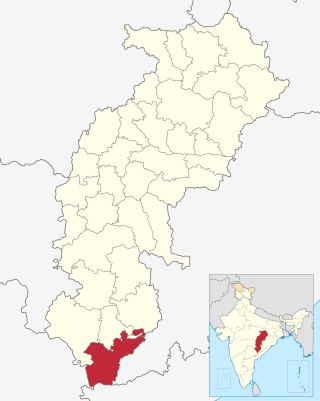
Sukma district is the southernmost district in the Indian state of Chhattisgarh. It is located in the Bastar region, known for its tribal culture. Sukma district borders with Odisha, Telangana and Andhra Pradesh.

Tourism is an important part of the economy of the Indian state of Chhattisgarh, India's tenth largest state. The state has many ancient monuments, rare wildlife, carved temples, Buddhist sites, palaces, water falls, caves, rock paintings and hill plateaus.

The following outline is provided as an overview of and topical guide to Chhattisgarh, an Indian state formed on 1 November 2000 by partitioning 27 Chhattisgarhi-speaking southeastern districts of Madhya Pradesh.
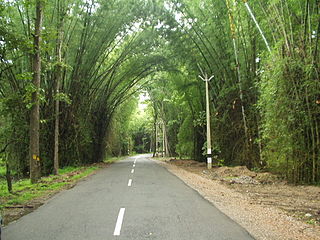
The Wayanad District of Kerala, India has a wide variety of tourist attractions ranging from religious sites to natural and historical sites. This district is divided into three towns: Kalpetta, Sultan Bathery and Mananthavady. All Major Tourism destinations in the district are maintained by the District Tourism Promotion Council.

Tourism in India is economically significant and projected to continue a pattern of growth. In 2016, the World Travel & Tourism Council calculated that tourism generated ₹14.02 lakh crore (US$160 billion) or 9.6% of the nation's GDP and supported 40.343 million jobs, 9.3% of its total employment. The sector is predicted to grow at an annual rate of 6.8% to ₹28.49 lakh crore (US$330 billion) by 2027.

The Sitabenga and Jogimara Caves, sometimes referred to either as Sitabenga Cave or Jogimara Cave, are ancient cave monuments nested in the north side of Ramgarh hills in Puta village, Chhattisgarh, India. Dated between the 3rd-century BCE to 1st-century BCE, they are notable for their non-religious inscriptions in Brahmi script and Magadhi language, and one of the oldest colored frescoes in Asia. Some scholars state that the Sitabenga cave is the oldest performance theatre on the Indian subcontinent, but others question whether it was indeed a theatre and suggest that it may have been a resting place (dharmashala) along an ancient trade route. The inscription at the Jogimara cave is equally disputed, with one translation interpreting it as a love-graffiti by a girl and a boy, while another translation interpreting it as a female dancer and a male sculptor-painter creating the two caves together to serve others. The inscription is also the oldest known mention of the word "devadasi", but this seems just a name and it is unlikely that this was related to any ancient Indian temple since the site and nearby area has no evidence of any Buddhist, Hindu or Jain temple built between the 3rd-century BCE and 8th-century CE.
Ram Van Gaman Path is the path that Lord Rama, Sita and Lakshmana took during their 'vanvaas' or exile years. It starts from Ayodhya and ends at Sri Lanka. This path is much revered in the Hindu religion as various key incidents of Lord Rama's life have taken place on this path.